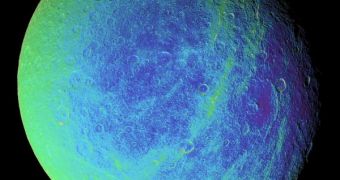Experts in charge of the NASA/ESA spacecraft Cassini, in orbit around Saturn, announce that the probe is today going to perform the second flyby ever of the gas giant's second-largest moon, Rhea. The first instance was back in 2005, just one year after Cassini arrived in orbit, and was conducted from a point of maximum approach of some 500 kilometers, or 300 miles. Today, March 2, Cassini will fly significantly closer to the mysterious natural satellite, at an altitude of just 100 kilometers, or roughly 60 miles. Scientists at the NASA Jet Propulsion Laboratory (JPL), who manage the mission, refer to the new flyby as R-2, or Rhea-2, they write on their official blog.
“Tuesday’s flyby should give us some clues about the suspected debris disk around the moon, but the slam-dunk experiment to 'see' Rhea’s debris disk is what we call a stellar occultation through the ring plane – looking to see if debris particles or clumps block out light from stars. Unfortunately we won’t get to do such an occultation on this flyby. This is a tricky experiment to do because you have to get the timing and the geometry just right, but we’re hoping to do it at some point later in the mission,” explains Cassini Ultraviolet Imaging Spectograph team member Amanda Hendrix, who is also the co-leader of the Satellite Orbiter Science Team.
Up until now, the moons Titan and Enceladus have been the primary targets for observations, mostly because of their particularly-interesting nature. The former features lakes of what appear to be liquid hydrocarbons at both its poles, whereas the latter continuously spews jets of ice and water particles from cracks in the surface of its south pole. These manifestations have won these two celestial bodies a lot of attention, as experts attempt to assess whether some forms of life would be possible on either of the two. As a result, a large part of the gas giant's other moons have been studied only in passing. The JPL group wants to remedy this in the case of Rhea.
“But wait – there’s more! Not only do you get a Rhea flyby, but we’re going to throw in a close approach to the small moon Helene! Helene is one of the 'co-orbitals' of Dione. That means it orbits Saturn at the same radial distance as Dione, but it happens to be 60 degrees ahead of Dione. Helene is only about 30 or 35 km across (19 or 22 miles) and it’s not spherical. Cassini will approach Helene within about 1,825 kilometers (1,130 miles) – by FAR the closest we’ve ever gotten to Helene – allowing the cameras and imaging spectrometers to obtain information about individual regions across the surface,” Hendrix adds.

 14 DAY TRIAL //
14 DAY TRIAL //